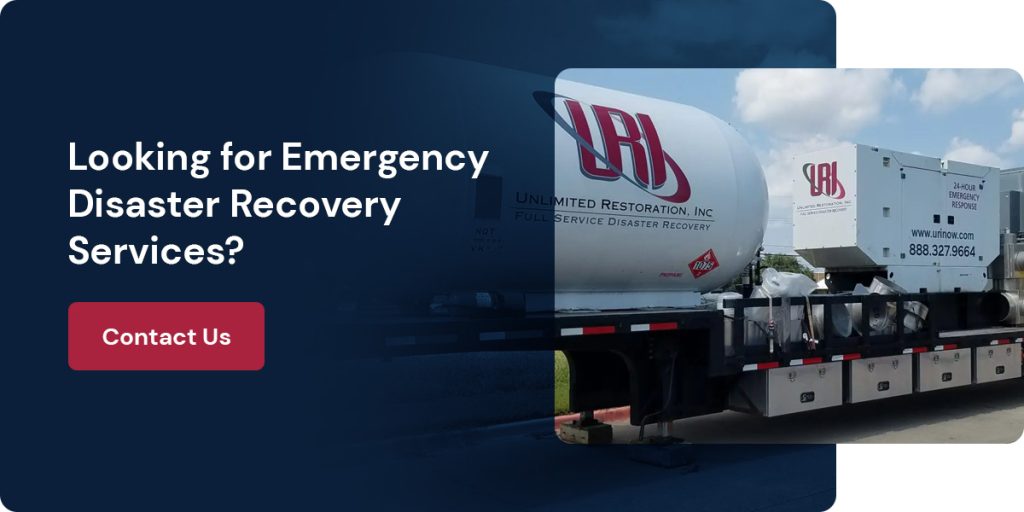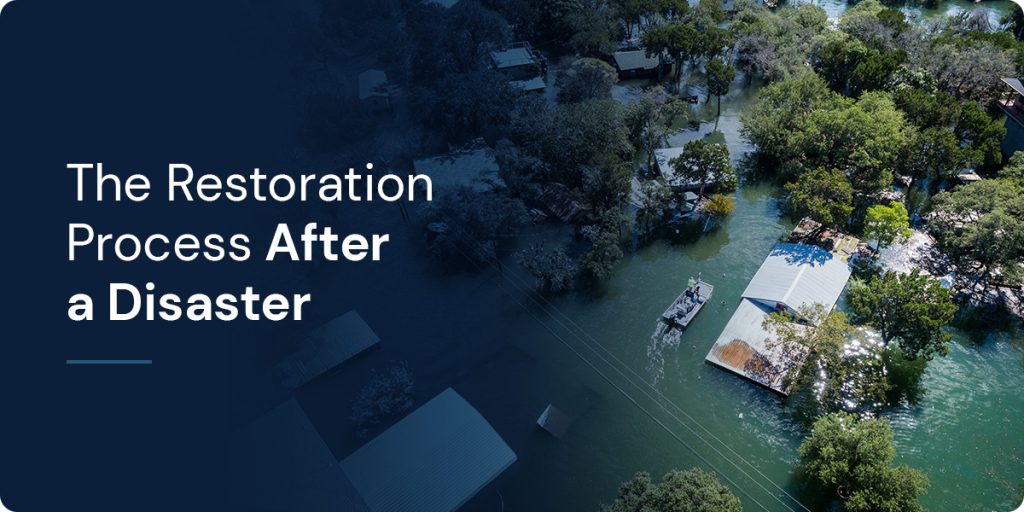
A natural disaster can unexpectedly and suddenly devastate communities, dismantling daily lives and business activities. While recovery often takes at least a few months to achieve, your business can take pre- and post-planning steps to help bounce back and aid your community after a natural disaster.
Understanding how you can reduce effects and start the restoration process can create a more resilient business that can give back to the community sooner. There are three parts of a disaster recovery plan — before, during and after.
While many businesses focus on what they can do in the face of a natural disaster or have procedures and timelines for after, your pre-planning can be pivotal in building your resilience and community presence. These pre-planning measures will take on two forms:
These policies and procedures can provide your business with a more comprehensive natural disaster recovery plan. When employees and managers know what to do, they can take more effective actions during and after disasters for a better restoration process.
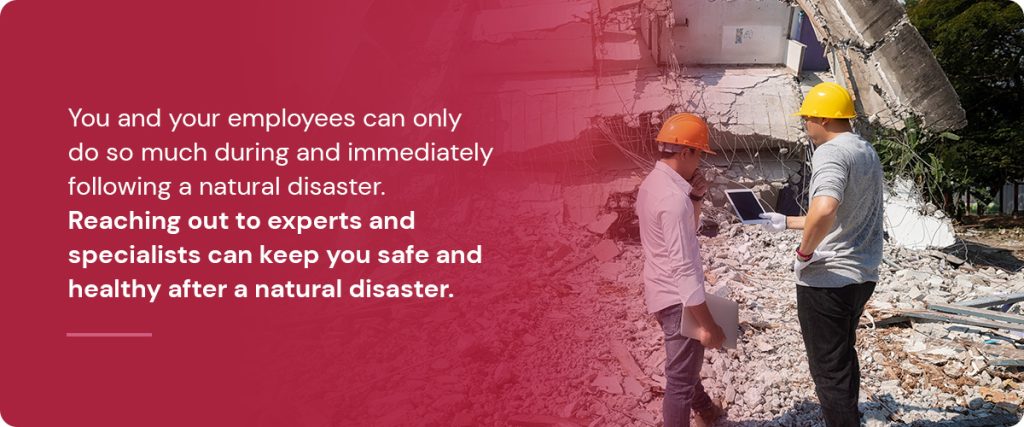
While having the right systems in place can help decrease the impact of a natural disaster, your actions during and immediately after can shape the future of your business. Taking the proper steps can help you limit the number of damages as you protect yourself and others from dangers and hazards.
Knowing who to partner with and contact for help is part of your immediate actions. You and your employees can only do so much during and immediately following a natural disaster. Reaching out to experts and specialists can keep you safe and healthy after a natural disaster.
Natural disasters cause chaos. You might have piles of debris and injured persons at the scene, regardless of any preparedness or mitigating protocols your business has in place. In the early stages following a natural disaster, you must seek help from emergency response services.
Emergency responders can carry out various services after a natural disaster. They can send medics to help treat and assess injuries sustained on the scene. If you have active hazards like fires, emergency responders have the proper training to handle these dangers to protect people and buildings. Quick responses after a natural disaster can help save lives and your business — the sooner they arrive, the more help they can offer.
Reaching out to emergency responders can put you into contact with vital volunteer and humanitarian organizations that can provide additional services. These organizations can help supply shelter, food and other necessities, helping communities affected by widespread natural disasters.
When facing extensive damages and pauses in business, your insurance policies can help mitigate some costs. If you have a plan covering natural disaster damages, file a claim with your insurance provider as soon as possible. Maintaining communication with your carrier can ensure you get the most out of your benefits.
When entering the claims process, remember to do the following:
When natural disasters make the future of your business uncertain, your insurance provider can work with you to start the restoration process. Following the proper procedure can ensure you get your benefits as soon as you qualify and get the most from your policies.
Stabilizing after a natural disaster means securing your site to prevent further damage. This process occurs in two steps — assessment and action. You’ll examine your site at the assessment phase to inventory all damage and potential dangers. This might include noting fallen structures, damaged equipment or loose electrical wires.
During the second stage, you’ll take steps to ensure your situation stays the same or improves. You might add some structural support to keep your roof and floors supported before removing and replacing other structures. Removing flood water can prevent further water damage and mold growth in your building. Addressing electrical and mechanical needs can help make your site safer for volunteers.
When stabilizing your business after a natural disaster, you must partner with the right organization with the training and tools to prevent damage safely. Unlimited Restoration offers emergency stabilization services for natural disasters. We train our teams to practice health and safety protocols, allowing you to protect yourself and your employees in the wake of a natural disaster.
A natural disaster is physically and mentally tolling on the mind and body. While you might want to throw yourself into the restoration process immediately, you can help your business by taking care of yourself first. When you prioritize your health and safety, you can ensure you’ll be ready to dedicate yourself to restoration efforts later.
Some ways to take care of yourself after a natural disaster include:
While you can start the restoration process immediately, it’s also essential to take care of yourself. You can better serve your business when you’re well and strong. Delegating tasks to other organizations or leaders can give you a chance you need to rest following a natural disaster.
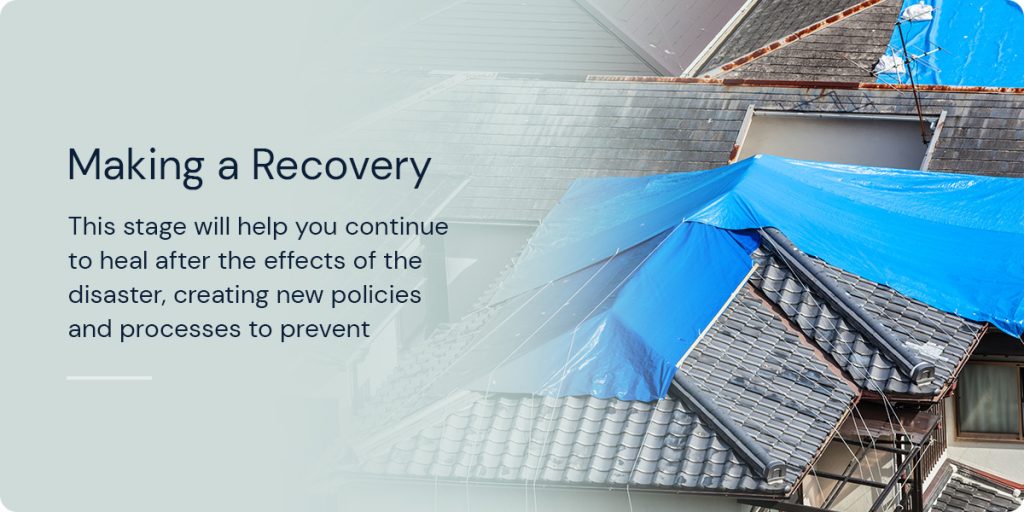
Once you have clearance to visit your business, you can begin responding to the damage. You can start to plan and execute repairs and restorations at this stage. Your previous actions can help establish the foundation for this step’s success. Your list of damages to your insurance provider can give you an idea of what you need to do, while your stabilizer’s reports and actions help ensure it’s safe for you to get started.
Even if you’ve already seen your facility or had it assessed by Unlimited Restoration, it’s always wise to look around it yourself. You can see first-hand what you still need to do and the severity of damages, which might not come across in pictures or reports.
Making your own assessment can also help you decide on your restoration priorities. The timeline of the restoration process is unique for each business, depending on the damages and their extent. However, you can make a rough repair schedule, starting with the most crucial and moving to lesser items.
How long does the restoration process take after a disaster? Because every restoration process is different, it can be challenging to put a timeline on the process. However, you might notice a shift in your efforts at some point between restoration and recovery.
Recovering from a disaster is different than restoration. While restoration involves making physical improvements to your business to return to structural and functional normalcy, recovery includes making a stronger enterprise that’s more resilient to challenges. This stage will help you continue to heal after the effects of the disaster, creating new policies and processes to prevent future disaster impacts.
The goal of the recovery period is to make your business more resilient to challenges. A resilient company can better withstand and recover from challenges because it has the tools and infrastructure it needs to reduce its effects. While a natural disaster can be devastating and stressful, it can help highlight areas where your business can become more resilient.
For example, a hurricane might highlight your company’s susceptibility to flooding and water damage. As you look to create a more resilient business, you might install better preventative and protective measures. For a flood, you might consider installing a sump pump, sealing windows and doors and moving electrical systems to higher levels.
As you build resilience, your business can become a more stable fixture within the community. Companies play an integral role in community recovery, helping boost the local economy and continue to provide essential goods and services. When businesses better withstand the effects of natural disasters, they can help create a more stable community that can quickly return to normal after a natural disaster.
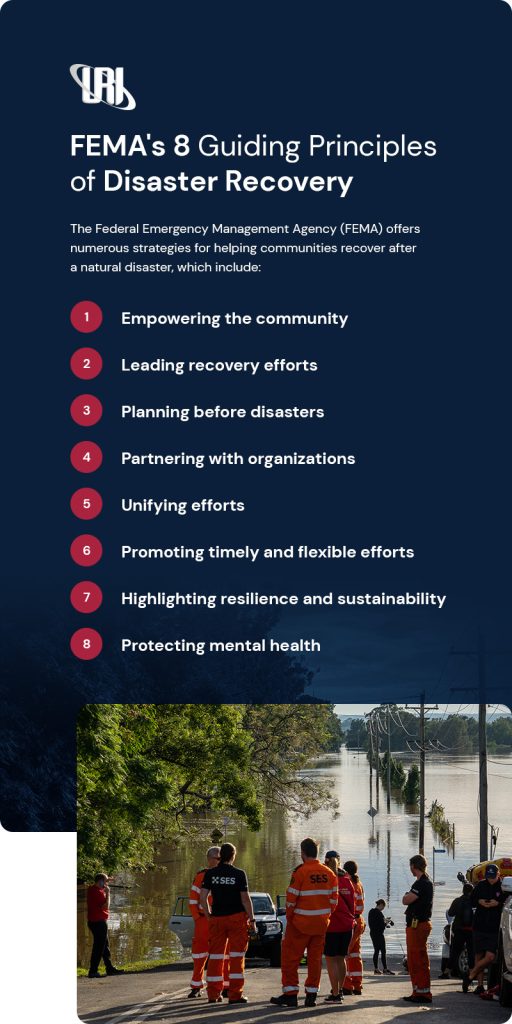
The Federal Emergency Management Agency (FEMA) offers numerous strategies for helping communities recover after a natural disaster, which include:
Partnering with the right organizations during recovery and restoration can give your business and community access to essential services and resources. Unlimited Restoration offers several restoration options, from specific restoration services like water damage to emergency response and restoration. Further, we can help you develop and access your restoration and recovery plan, ensuring you can always follow the policies and procedures you created.
Contact Unlimited Restoration and discover the role we can play in your community and business recovery.
